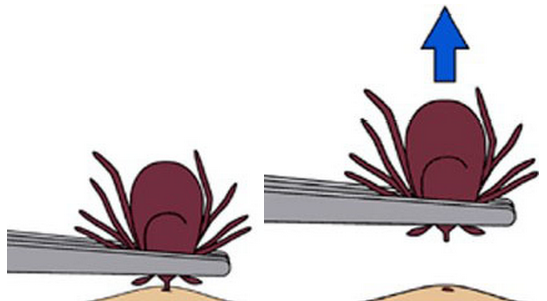Lyme Disease in Dogs - Steps To Remove Ticks
For pet owners who have an indoor-outdoor dog, we recommend that you pay attention and learn about Lyme Disease Prevention Month in Dogs, this April 2017.
About the Black-legged Tick
 Black-legged ticks are the most common type of tick in North America carrying the notorious tick-borne disease, Lyme Disease. Although Lyme is more of a concern for humans, it does harm dogs in addition to other dog tick illnesses such as Rocky Mountain Spotted Fever, spread by American Dog Ticks.
Black-legged ticks are the most common type of tick in North America carrying the notorious tick-borne disease, Lyme Disease. Although Lyme is more of a concern for humans, it does harm dogs in addition to other dog tick illnesses such as Rocky Mountain Spotted Fever, spread by American Dog Ticks.
Lyme Disease is generally spread by ticks within 24-48 hours of attaching to a human or dog. If your dog is experiencing the following symptoms, then the dog may have a tick bite.
- Regurgitation
- Unsteadiness
- High blood pressure
- Fast heart rate and rhythm (tachyarrhythmias)
- Weakness, especially in the hind limbs
- Partial loss of muscle movements (paresis)
- Complete loss of muscle movement (paralysis), commonly seen in advanced disease state
- Poor reflexes to complete loss of reflex
- Low muscle tone (hypotonia)
- Difficulty in eating
- Disorder of voice (dysphonia)
- Asphyxia due to respiratory muscle paralysis in severely affected animals
- Excessive drooling (sialosis)
- Megaesophagus (enlarged esophagus)
- Excessive dilatation of pupil in the eye (mydriasis)
The most common sign of Lyme is a ring around the infected skin, also known as the 'Bulls Eye' marking. Clinical illness in dogs lasts from 2-5 months; and can be treated with antibiotics like Doxycycline or Amoxicillin, if caught in the early stages.
Some dogs that develop kidney disease from #Lyme become severely ill or die. See a vet as soon as you successfully remove the dog tick from your pet's skin.
How to Remove a Tick
Removing a tick species is easy; but pet owners must keep calm as to not startle the dog.
Here are the steps to remove ticks:
Step 1: Purchase a Tick Removal Tool
Household tweezers may not be strong enough to successfully remove the tick. We suggest purchasing a tick remover tool from EasyPetFence.com for easy handling. Tick tweezers allow the user to gently remove the tick from the infected area with ease. With a tick tool, users will have peace of mind knowing that all parts of the tick are successfully removed from the skin.
Step 2: Disinfect the tick-biting area with rubbing alcohol or soap and water.
Step 3: Pull the tick straight up. Be sure that the head and body both comes out completely. (Remember: Tick-borne disease transmission is not possible without the tick's head as this is what is burrowed inside the skin.) Do not rush the process so the tick's body does not break apart. If it does break for any reason, remove the broken parts from the infected area - do not leave the remaining body parts attached to your skin.

Step 4: Disinfect the tick-biting area with rubbing alcohol one final time.
Step 5: Place the tick in a sealed container. Store in refrigerator if it is alive, and the freezer if it is dead.
Step 6: Take the tick to a doctor's office quickly for testing to identify the type of tick; and consider testing for Lyme Disease and other diseases.
To safeguard pets this Dog Tick Prevention Month, EasyPetFence encourages homeowners to install a dog fence around properties to keep out wildlife that may be carrying ticks.
